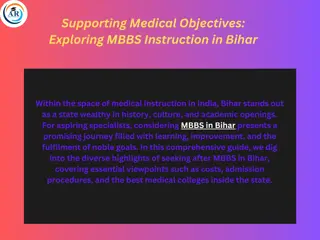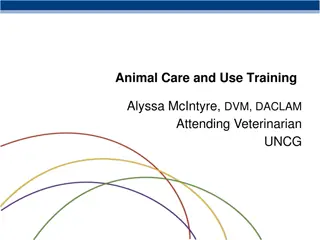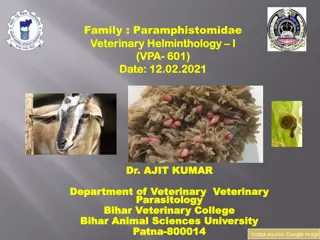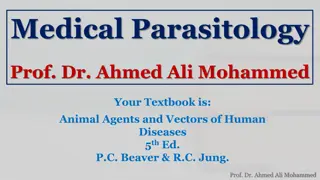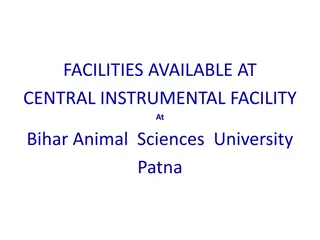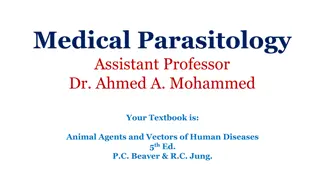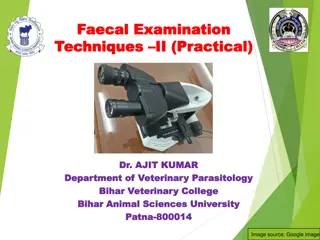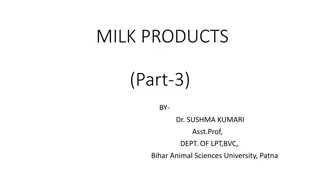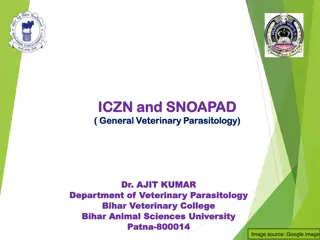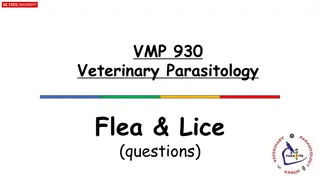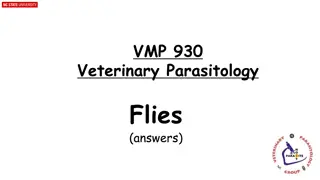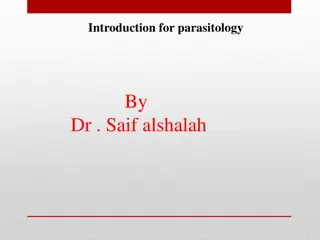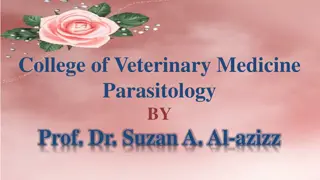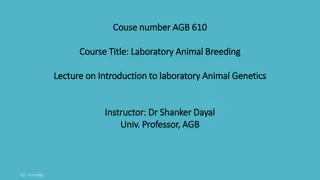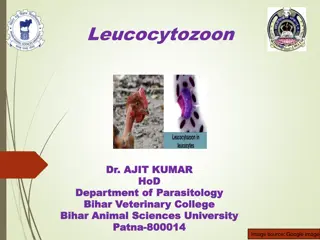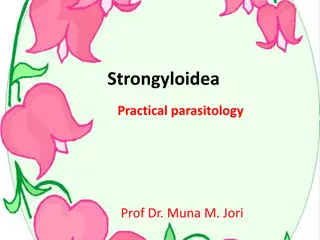Parasitology at Bihar Animal Sciences University
The Bihar Animal Sciences University, under the family Paragonimidae, conducts research on parasites like the Oriental lung fluke. The university describes the features, hosts, and infection modes of these parasites.
Download Presentation

Please find below an Image/Link to download the presentation.
The content on the website is provided AS IS for your information and personal use only. It may not be sold, licensed, or shared on other websites without obtaining consent from the author.If you encounter any issues during the download, it is possible that the publisher has removed the file from their server.
You are allowed to download the files provided on this website for personal or commercial use, subject to the condition that they are used lawfully. All files are the property of their respective owners.
The content on the website is provided AS IS for your information and personal use only. It may not be sold, licensed, or shared on other websites without obtaining consent from the author.
E N D
Presentation Transcript
Bihar Animal Sciences University | Family: Family: Paragonimidae Paragonimidae Dr. AJIT KUMAR Dr. AJIT KUMAR Department of Veterinary Veterinary Department of Veterinary Veterinary Parasitology Parasitology Bihar Veterinary College Bihar Veterinary College Bihar Animal Sciences University Bihar Animal Sciences University Patna Patna- -800014 800014 Image source: Google image
Body of the parasite is oval to fusiform. Whole body is highly bifid spiny. Oral sucker is subterminal oesophagus is short but caeca is long. Ventral present on anterior part of the body. sucker too small
oTestes lobed, symmetrical in position and present in the posterior part of the body. o oGenital pore ventral sucker. just behind oovary lobed located between ventral sucker Uterus is coiled. oExcretory vesicle extends up to oesophagus. and testes.
Species Species Final host Final host Intermediate Intermediate host host 2 2nd intermediate intermediate host host nd Location Location Paragonimus westermanii ( Oriental ( Oriental lung fluke) lung fluke) Pig, dog, cat, Cattle, goat, fox and man. Melania, Hua, Ampullaria, Assiminea sp. (snails) Cray fishes & crabs ( Eriocheir, Patomon spp.) Mainly in lungs P. kellicoti Wild animals, cat, dog & Pig -do- -do- -do-
Common name: Oriental lung fluke Final host- Pig, dog, cat, cattle, goat, fox and man. 1st Intermediate host:- Melania, Hua, Ampullaria, Assiminea sp. (snails) 2nd Intermediate host: Cray fishes & crabs ( Eriocheir, Patomon spp.) Infective stage:-Metacercaria infected carbs Mode Mode of Location: -lungs of infection infection: : by by ingestion ingestion
Cercariae are emerge out from the infected snail and then penetrate into the crabs and cray fishes in which they metacercaria. encyst to become Final hosts get the infection by the ingestion of metacercaria infected raw or undercooked crabs or cray fishes. The cercaria has very short tail or stumpy called microcercous microcercous cercaria cercaria.
Eggs Eggs are where where they cyst cyst to to the are deposited deposited in they are are voided voided through the outside outside either in the the cystic through the either with with sputum cystic pocket the opening opening of sputum or pocket from from of the the faeces. . or faeces Each Each Cyst parasites parasites surrounded surrounded by with with blood blood and and eggs Cyst in in lungs lungs usually by a a purulent eggs. . usually contains purulent fluid contains two fluid mixed two mixed Migrating Migrating immature peritonitis, peritonitis, granulomatous granulomatous pneumonia immature flukes bronchiolitis bronchiolitis pneumonia. . flukes cause cause eosinophilic eosinophilic and and chronic chronic
Rusty Rusty colour bronchial cough with thick sputum containing a little blood and the eggs of the parasites, sneezing colour sputum sputum which is similar to those of Haemoptysis following paroxysmal coughing. In characteristically producing a Jacksonian type of epilepsy man causes cerebral paragonimiasis
On the basis of Characteristic Clinical signs (Rusty colour colour sputum sputum ) Rusty Microscopic examination of sputum/ faecal sample which reveals the presence of characteristic eggs of Paragonimus westermanii. Eggs are yellowish-brown in colour, operculated and thickened at the pole opposite this. . the shell is
Albendazole @ 5-100 mg/kg/day Niclofon @ 1mg/kg b. wt daily for 3 consecutive days Bithionol@ 100mg/kg daily for 7 days Control: Uncooked or raw crabs should not be eaten Destruction of snails Improving sanitary measures b. wt
Spiny cuticle Tapering anteriorly and rounded posteriorly Broad posteriorly much lobulated bunches of grapes lie in the lateral field. Genital pore situated next to the oral sucker ovary and vitellaria like Oval testes lie horizontal at the middle of body the Redia stage absent.
Species Species Final host Final host Intermediate Intermediate host host 2 2nd intermediate intermediate host host nd Location Location Prosthogoni mus ovatus Domestic fowl & Geese. Bithynia leachi & Gyraulus spp Nymphal (naiads) stage of dragon fly ( Sympatrum decoloratum) Bursa of Fabricius & Oviduct P. pellucidus -do- -do- -do- -do-
Common name: Oviducal fluke or Oviduct fluke Final host- Domestic fowl & Geese. 1st Intermediate host:- Gyraulus spp (snails) 2nd Intermediate host: Nymphal (naiads) ( Sympatrum Infective stage:-Metacercaria infected naiad or the adult fly. Mode Mode of of infection infection: : by by ingestion ingestion Location: - Bursa of Fabricius , Oviduct Bithynia leachi & stage of dragon fly decoloratum)
LIFE LIFE- -CYCLE OF P. OVATUS CYCLE OF P. OVATUS Egg Miracidium Miracidium Sporocyst Sporocyst INSIDE INSIDE THE THE Daughter sporocyst Cercaria Cercaria SNAIL SNAIL cercaria emerge fromsnail & enter dragon fly Form metacercaria inside dargon fly
Acute inflammation oviduct, of the production of abnormal eggs and discharges of albumen from the cloaca and peritonitis
Symptoms include laying of the eggs with soft shells or without any shell, milky discharge from the cloaca containing calcareous material feathers in perineal region. Marked tendency to sit on the nest. Abdomen is pendulous and the legs are held widely apart in walking which soils the The disease is usually seen in spring or early summer.
Microscopic examination of cloacal discharges for presence of eggs. Eggs are perculated, dark-brown bear a small spine at the pole opposite to the operculum.



